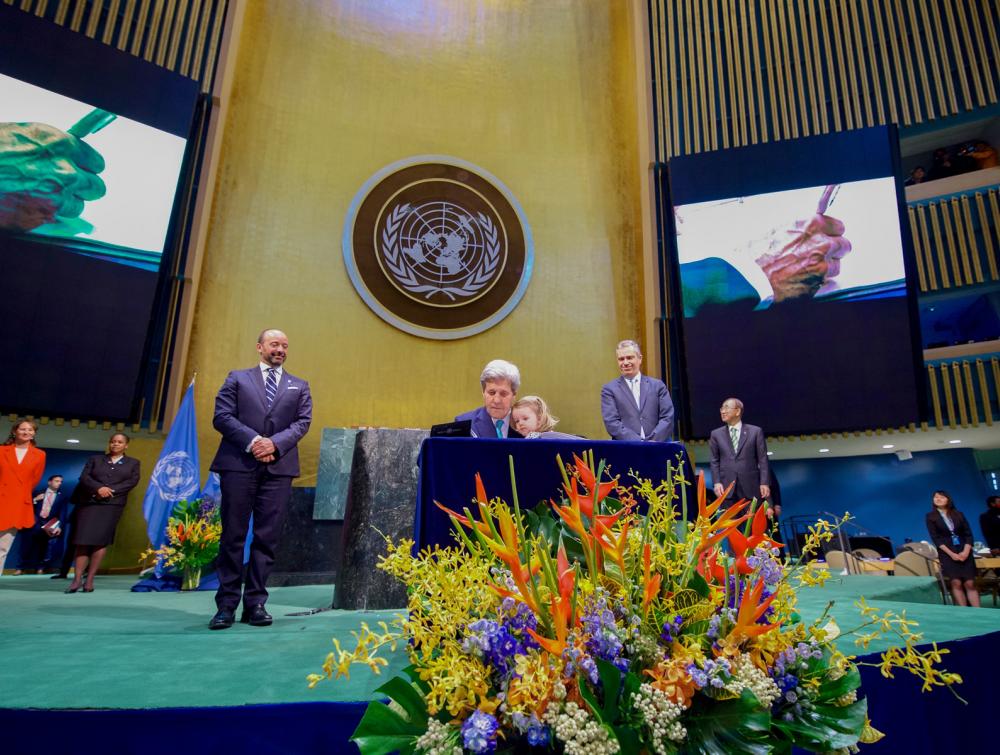Keeping U.S. emissions in line with Paris agreements is within sight

U.S. Secretary of State John Kerry signs the COP21 Climate Change Agreement on behalf of the U.S. in 2016
U.S. Department of State, Flickr
Comprehensive approach must include our public lands
Last week, a non-partisan think tank released a report supporting the importance and urgency of aligning fossil energy production on public lands with U.S. climate commitments—a commonsense step in making our public lands part of the climate solution.
Specifically, the report from the Seattle-based Stockholm Environment Institute outlines a path for reducing U.S. climate emissions from our shared lands to the levels necessary to keep global warming below 2o Celsius, where scientists have said many climate change-related disasters will become exponentially worse.
This study reiterates what we’ve found time and time again: our national climate strategy has a blind spot with regard to how we manage our federal oil, gas, and coal production—our national climate commitments are not being taken into account, and our lands are not being managed for what is ultimately needed to prevent catastrophic climate change.
What we need is a holistic and comprehensive approach to managing our public lands in a way that doesn’t exacerbate the climate crisis. This strategy must be in tandem with our other public lands goals, including protecting places too important to drill or mine and modernizing the federal agencies responsible for managing our lands and minerals to meet the expectations of a 21st-century America.
The Obama Administration has begun to address this issue in some distinct ways:
- Taking a comprehensive look at the federal coal program, including the program’s climate impacts. As this process moves forward, the public will have an opportunity to urge action and ensure that this administration, and future ones, accurately account for, consider, and mitigate any climate implications from the development of coal on federal lands.
- Issuing important guidelines governing oil and gas development on federal lands. The Bureau of Land Management is moving forward with standards to prevent the loss of natural gas on federal lands through venting, flaring, and leaks. Methane, which is the main component of natural gas, is a powerful greenhouse gas, up to 86 times more damaging than carbon dioxide, and the BLM’s new natural gas waste rule will greatly reduce the amount of methane from our shared resources in the atmosphere. This will only help reduce our public lands’ contribution to climate change.
- Pursuing smart-from-the-start renewable energy planning on public lands to ensure that more solar, wind, and geothermal is developed more quickly, in a smarter way, and away from sensitive landscapes. Continuing this approach to renewable energy on federal lands will only increase the amount of renewable and sustainable energy going to our homes and reduce our reliance on climate change causing fossil fuels.
While these policies are moving us in the right direction, they are not enough on their own. As a country, we must take a complete look at how we develop fossil fuels and resources on our federal lands. It starts with a public, transparent effort from the federal government to accurately measure and account for how much carbon our shared resources are contributing to the atmosphere. This administration has started to develop a plan for addressing this issue, but that is just the beginning.
We also need land management agencies like the BLM to use these measurements to actually reduce climate change emissions from federal lands. Our shared lands should not continue to contribute greatly to climate change. As our leaders look at all sorts of ways to reduce carbon emissions—like ensuring cars and trucks are more efficient with gasoline and power plants needing to cut emissions from their smoke stacks—it only makes sense to apply the same logic to resources that are owned by all of us.
Finally, we cannot assume lands already leased are appropriate for development. We must take stock of public lands already leased for oil and gas and ensure that areas that were improvidently leased are not developed, and that other areas are developed diligently rather than stockpiled for an uncertain future.
With two-thirds of lands leased for development sitting idle, and many of those leases off the books and in industry hands, we are in need of a more comprehensive path forward for managing federal resource development than simply hitting the brakes on all new leasing.
Our federal lands are crucial for tackling climate change, and they must be managed with that in mind.
